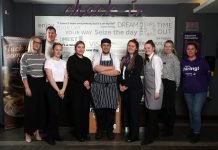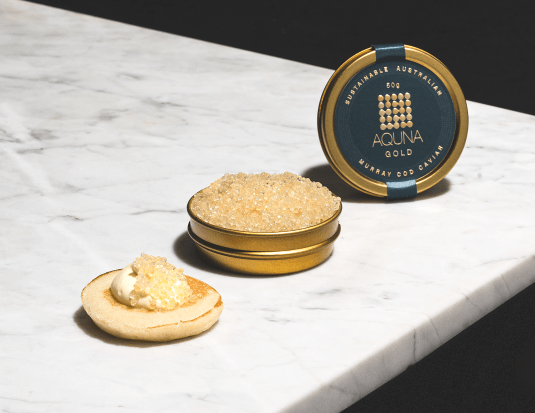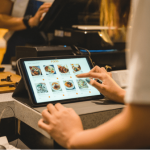The fin-to-tail movement has seen many innovations — ice cream made from fish eyes, hand rolls packed with tuna scrapings, and collars deep-fried and covered in seasoning. Believe it or not, caviar is one of the original seafood byproducts, selling for around $1 per pound in the 19th century before it became a sought-after commodity.
Eggs from sturgeon, salmon, trout, and scampi are used across the globe by chefs, and now there’s a new addition to the caviar family from our very own Murray cod. Aquna Sustainable Murray Cod’s Ross Anderson and Simon Johnson’s Lisa Downs reveal how the product came to life, the retrieval and curing process, and how Murray cod caviar is one of the most unique products in the world today.
Trade shows are incubators for ideas, and there’s no better hub to talk fish than at the Seafood Expo in Boston. It’s where caviar ambassador Lisa Downs met with reps from Aquna Sustainable Murray Cod and a question was posed. “They said, ‘I wonder what it would be like to try the caviar?’” says Aquna Chairman Ross Anderson. “It was something I had thought about a few years beforehand, but we were so busy selling fish we didn’t focus on it.”
Aquna moved close to 500,000 tonnes of cod last year, to give you an idea of the demand. “Lisa saw Josh Niland had made some [caviar] and it gave her the idea to have a crack, so they developed it from there and she put the time and effort into it.”
Aquna has eight sites in the Riverina region of New South Wales (plus contract farms) where fish are hatched, reared, and processed. The cod are grown in native river water from the Murray-Darling basin and are both a localised and exclusive product as there is no wild catch of cod for commercial sale in Australia.
“When we started a decade ago with 20–30 tonnes of fish, people never thought we would sell it all,” says Anderson. “We have millions of fish in the water now, but the demand is always five to six times the supply.” There’s no doubt popularity and consumer awareness go a long way when it comes to launching spin-off products, which made the development of Murray cod caviar a close-to sure bet.
Downs is one of the industry’s go-to caviar figures and has an unrivalled knowledge when it comes to the product, having worked on farms across the globe alongside top-tier producers. She identified an opportunity to develop a unique caviar from a part of the fish that was once discarded. “They used to throw the egg sacs away, and now we have made a beautiful product from a byproduct,” she says. “We have added more value to the female fish and it’s uniquely Australian.”
The egg retrieval process takes place during spawning season, which occurs from September until October each year. But first, the farming process. “We have three stages of production where we start with larvae and hatching and then they go to juvenile and then to grow out,” says Anderson. “Once the fish are in the grow-out area, it’s a matter of identifying larger female fish with the capacity to spawn a year or so later. The fish are sorted and then we put the larger females away for an extra year and harvest the roe when spawning season comes around.”
Downs flew to Griffith to demonstrate how to remove the eggs from the sacs at Aquna’s processing plant and now once the eggs have been extracted on-site, they are snap-frozen and sent to Simon Johnson in Sydney’s Alexandria, where Downs and the team get to work.
“We defrost the eggs and add 6 per cent Murray River salt which is a nice synergistic thing,” she says. “Once we mix in the salt, there is no other interference. We don’t need to mature it in a mother tin like sturgeon caviar — we just need the salt to penetrate the membrane a little bit. We pack them into 50g tins from the curing mix, take all the air out, and let the salt interact with the membrane for about a week and then it’s ready.”
While the maturing process is comparable to sturgeon caviar, the time required is vastly different — as is the mouthfeel. The fat levels in cod eggs are much lower than sturgeon eggs, which means the salt only needs to interact with the membrane rather than penetrate it. The eggs also undergo a colour transformation during curing, changing from white to transparent Champagne once they interact with the salt.
A short curing time of just one week is a big plus for customers, as the roe is packed and distributed on a weekly basis by Simon Johnson. “We have fresh roe all the time which is the ideal scenario,” says Downs. “Quay has been buying 30 tins a week and the uptake has been really amazing.”
The world caviar has certain connotations — the words salty, rich, expensive, and buttery likely spring to mind. But cod caviar has a unique flavour profile of freshwater notes and is best consumed in a different manner to sturgeon caviar. While you can certainly enjoy it on a blini with a mound of crème fraîche, it’s best used as a garnish. “You don’t eat a spoon of it like you would sturgeon caviar,” says Downs. “The intent for this product is to add texture and a briny, crunchy pop.”
Quay’s Peter Gilmore has been using it in a dish of raw Abrolhos Island scallops with smoked eel cream and sea cucumber crackling. “I like the fresh saltiness of it, and the crunch,” says Anderson. “Some chefs pair it with carpaccio or run it through pasta which comes out beautifully.”
Murray cod caviar has already been attracting interest, with enquiries coming in locally and from restaurants overseas, too. The product is also more accessible, and retails for $72.95. “I think it’s fairly priced with to enter the marketplace,” says Anderson. “It is the rarest caviar in the world we know of, and it comes from a unique Australian provenance with a unique Australian story.”
The post A deep-dive into Australian Murray cod roe appeared first on hospitality | Magazine.































